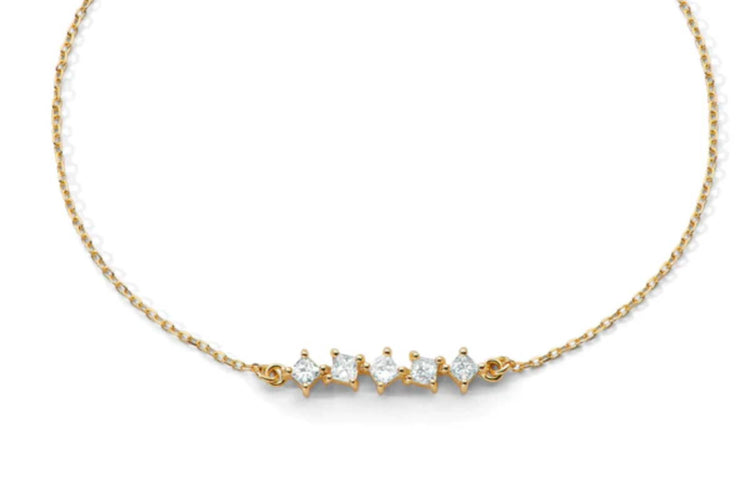By Beth Bernstein
Geometry Rules the Princess Cut
No one really knows how the princess cut got its name—it went through many different terms and style iterations before becoming one of the four most desirable engagement rings today. Among all of the various diamonds and diamond cuts, it is in good company with the brilliant cut, oval and cushion cut. Princess cut diamonds have as much sparkle and life as the modern brilliant but chosen by couples who prefer geometric shapes and cleaner streamlined settings. One would think by its title, it was linked to early royalty or nobility but in reality, it was dubbed princess cut in the 1980s.
So let’s go back in time and start at the beginning.
Evolution of Princess Cut Diamonds - From 14th To The Early 20th Century
The princess cut is a distant relative of the table cut (reported as the first shape in the history of diamond rings and cuts), which dates back to the 14th century. Since the table cut was the first shape of diamond, it became extremely popular with European nobility and aristocracy during this time. And as with every diamond, advances in cutting tools and techniques were made, allowing more facets, brilliance and sparkle were added. In this particular shape, the facets were added to the crown area of the diamond, offering more fire and reflected light.
Another interested facet (pun intended) was that cutters of the time wanted to optimize the rough diamond which were often shaped as octahedrons when they came out of the ground. When you looked at the rough diamond it seems like two pyramids connected at their flat bottom. When square cut diamonds were shaped from the octahedron, much less diamond was cut away, allowing for much more carat weight, which is the same with today’s princess cut. But let’s not get ahead of ourselves.
In the early 20th century, the more primitive shapes were given more facets, usually 18-24, and became known as the French Cut diamond. This incarnation retained much of its original rough shape while producing some serious sparkle. It became one of the predominant shapes of the Art Deco period—the age of streamlined design in architecture, fashion and travel which jewelry of this period captured in elegantly pared down ultra-modern pieces. The French cut was used as center stones in diamond dress and engagement rings, eternity bands, line bracelets, and wide Deco bracelets mixed with other fancy cuts. The classic French cut features a rhombus-shaped table sitting on top of a square or rectangular-shaped crown.
Becoming A Princess Cut Diamond Ring
The French cut took a on slightly different more sleek shape in what was referred to as the square modified brilliant cut, which came onto the diamond scene during the early 1960s. Cutters learned more about the placement of the facets and once again advancements in technology and tools aided in creating diamonds that reflected more light and produced more fire, lively sparkle and scintillation. Two different diamond cutters created diamonds during the ‘60s that were similar in shape and feeling and close to what we know as the true princess cut. Arpad Nagy, a London-based diamond cutter created a new square diamond cut that he named the Profile Cut. Basil Watermeyer, a South African cutter came out with a slightly more rectangular shape with 81 facets called the Barion cut at approximately the same time. There were a series of these diamonds up until the ‘70s that combined the brilliance of a round with a shape similar to that of an emerald cut. Then in Israel in 1979, two diamond cutters working together—Betazel Ambar and Israel Itzkowitz perfected the “quadrillion” cut, which is most similar to the modern princess cut, which saw tremendous popularity in the 1980s and has become as desirable for engagement rings again today. Although it’s lineage dates back centuries, the contemporary princess-cut is one of the newest shapes in diamonds. It’s square cut with pointed corners and inverted pyramid base. It can be either perfectly square or slightly rectangular depending on its length to width ratio. The top faceting creates a brighter and more brilliant look as it allows more light in to show off a stunning princess cut diamond ring.
Unlike other geometric cuts such as the emerald or Asscher, which produce flashes of light, the princess diamond is cut to maximize sparkle and provide the fire and brilliance, found in a round, oval or cushion cut. It is also one of the cuts that evokes a timelessly sophisticated yet highly contemporary feeling when set as a solitaire which is why it has become a cut of choice among millennials for engagement rings. It has been a popular diamond ring cut for celebrities.
Beth Bernstein is a jewelry historian, collector of period and modern jewelry and a purveyor of all things sparkly. She has penned three books—'My Charmed Life,' a memoir; 'Jewelry's Shining Stars,' a modern jewelry design coffee table book; and 'If These Jewels Could Talk,' an in-depth look at celebrities and the stories behind their legendary jewels on the silver screen and in real life—with a fourth one in the works. She has written and continues to write for major print and online magazines on all subjects pertaining to jewelry and style.



